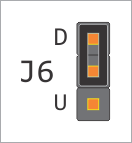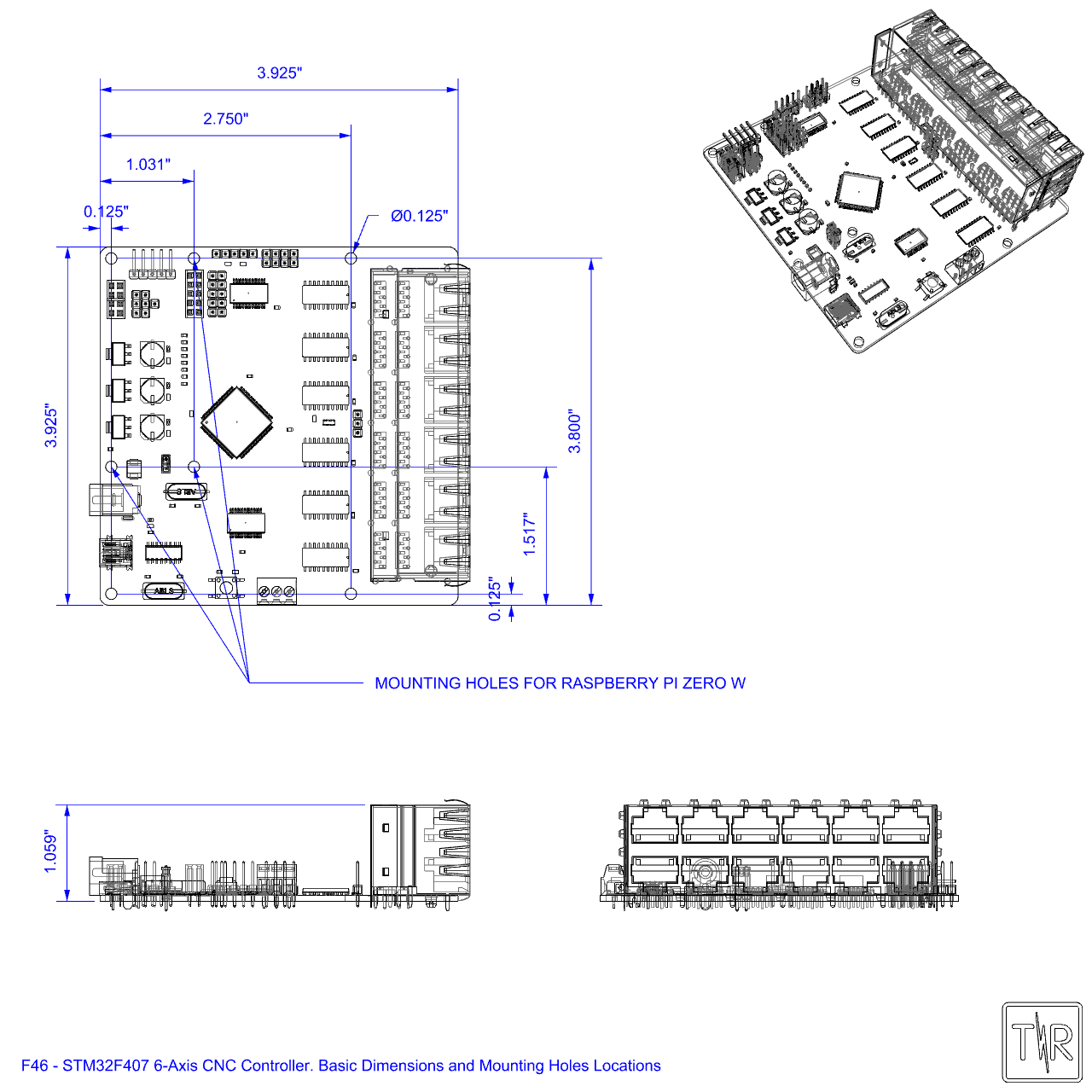1. Board Components
- Mounting Holes (4 holes - 1 is shared with Raspberry-Pi Zero). This mounting hole location (upper left corner) is connected to GROUND.
- Wifi Module Header (8 pins), for ESP8266 ESP-01 module (optional)
- Communication Selection Jumper group.
- Firmware Programming Jumper (J7).
- Raspberry-Pi Zero Module mounting (4 holes), using standoff.
- Main Power Connector. Tip Positive, DC 12V 1A recommended.
- USB mini Connector, for Main Communication (using onboard CH340 USB to Serial Chip)
- Reset Button for STM32F407VET6
- Power Out Screw Connector (3 pins)
- Dual Row RJ-45 2X6 (12 Ports) for peripheral connections.
- System Control Signal Pull Up/Down Selection Jumper (J6)
- Header for SPI communication (8 pins).
- Header for I2C communication (5 pins).
- Header for Digital Inputs (10 pins).
- Raspberry-Pi Zero Module header (10 pins).
- Header for Firmware Programming (5 pins).
2. Peripheral Connections
Connection to all breakout boards are RJ45 (ethernet). CAT-5 or CAT-6 cables can be used in most cases, for longer cable run than 2 meters, CAT-7 is highly recommended. Connection of up to 10 meters has been tested with CAT-7 cable. The shield is connected to GROUND.
- X-Axis. Applicable Breakout Modules : AD1, AD2, AB1.
- Pin 1: STEP
- Pin 2: DIR
- Pin 3: Limit-P
- Pin 4: Limit-N
- Pin 5: Home
- Pin 6:Enable
- Pin 7: 5V
- Pin 8: GROUND
- Y-Axis.
- Z-Axis.
- A-Axis.
- B-Axis.
- C-Axis.
- [PWM-AUX.A]. Auxiliary PWM Outputs (1 to 4), group A. Applicable Breakout Modules: PW4, BB1.
- Pin 1: PWM1
- Pin 2: PWM2
- Pin 3: PWM3
- Pin 4: PWM4
- Pin 5: 5V
- Pin 6: 5V
- Pin 7: 5V
- Pin 8: GROUND
- [PWM-AUX.B]. Auxiliary PWM Outputs (5 to 8), group B.
- Pin 1: PWM5
- Pin 2: PWM6
- Pin 3: PWM7
- Pin 4: PWM8
- Pin 5: 5V
- Pin 6: 5V
- Pin 7: 5V
- Pin 8: GROUND
- [SPINDLE/LASER] Control. Applicable Breakout Module: BB1.
- Pin1: PWM
- Pin 2: DIR
- Pin 3: ENable
- Pin 4: Coolant Mist
- Pin 5: Coolant Flood
- Pin 6: Not Used
- Pin 7: 5V
- Pin 8: GROUND
- CNC [CONTROL]. Applicable Breakout Module: BB1.
- Pin1: Emergency Stop
- Pin 2: Feed Hold
- Pin 3: Cycle Start
- Pin 4: Safety Door
- Pin 5: CNC Reset
- Pin 6: Probe
- Pin 7: 5V
- Pin 8: GROUND
- [DIG.AUX]. Auxiliary Digital Outputs (1 to 8). CAT-7 cable is required (for GROUND). Applicable Breakout Module: BB1.
- Pin 1: AUX1
- Pin 2: AUX2
- Pin 3: AUX3
- Pin 4: AUX4
- Pin 5: AUX5
- Pin 6: AUX6
- Pin 7: AUX7
- Pin 8: AUX8
- [ALT.COMM] Alternate Communications: I2C and SPI. Applicable Breakout Module: BB1.
- Pin 1: SPI SCK
- Pin 2: SPI MISO
- Pin 3: SPI MOSI
- Pin 4: SPI CS
- Pin 5: I2C SCL
- Pin 6: I2C SDA
- Pin 7: 5V
- Pin 8: GROUND
Examples of Peripheral Connections:
3. Mounting Holes
Mounting Holes Locations. The holes' size is 0.125" (3.16mm), the pad size is 0.225" (5.72mm). Suitable standoffs and screws are 4-40 or smaller for imperial, M3 or smaller for metrics. For mounting the Raspberry Pi Zero W, M2.5 standoffs are recommended due to the smaller mounting holes on the Pi Zero.
If the final integration requires a chassis ground, the upper left hole/pad is connected to ground.
4. Jumper Settings
(3) Communication Selection Jumper group

Default: Communication is via onboard USB to serial (CH340 chip).

Communication via Raspberry-Pi Zero

Remove all jumpers when the optional WiFi Module is connected. The user can also connect a TTL-Serial UART directly. Popular choices include CH340, FTDI, CP2102, or another micro-controller for custom implementations. Connect the UART TX pin to the indicated rx pin, similarly RX to tx, and Ground to gnd. Comm Baud Rate is 921,600.
(4) Firmware Programming Jumper (J7)

Default: jumpered for normal operation. Remove jumper for firmware programming.
(11) System Control Signal Pull Up/Down Selection Jumper (J6)

Default: Apply Pull-Up to Control inputs

Apply Pull-Down to Control inputs.
5.1 Board Connections: Power
(6) Main Power Connector.
Main power for the board is via a standard 5.5mm x 2.1mm tip-positive connector. The board will accept power supplies from 5V to 12V. There are three voltage regulators (AMS1117), each to provide power to different components on the board:
5V : for STM32F103 and all other components.
5VPi : for Raspberry Pi Zero if connected.
3.3V : for WiFi Module (ESP-01) if connected.
Depending on the final configuration, the recommended power supply is as followed:
For board logic only : 5V 1A
With either Raspberry Pi Zero or WiFi Module : 6V 2A
5.2 Board Connections: Communications
The F46 has four different ways for communication with the STM32F407. See above jumper settings, Communication Selection, to configure the board. Comm Baud Rate is 921600.
- Using the built-in USB to Serial UART (CH340). Connect the USB mini cable to the USB mini port (7).
- Using the Raspberry Pi Zero. Connect the Raspberry Pi Zero to the 10 pin female header (16), note the mounting hole locations.
- Using the WiFi Module. Connect the ESP-01 Modulde to the 8 pin female header (6), the direction of the mount should have the antenna section hanging outside the board.
- Using an external Serial UART. Connect the TX, RX, and GROUND pins from the external UART to the rx,tx,gnd pins (respectively) at the labeled pins (see bottom silkscreen or above jumper settings)
Note: only ONE method can be active at any one time. Disconnect all others. For example, if using the built-in USB to Serial (method 1), the Raspberry Pi and the WiFi Module should be disconnected.
The F46 has both SPI (12) and I2C (13) available for communication with other devices. Implementation will be via Custom M-codes. Being planned for a future release is a 4x20 LCD digital readout (DRO) via I2C showing the axes' positions. SPI and I2C are also available on the RJ45 peripheral connection (12).




